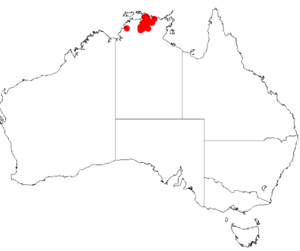Acacia lacertensis facts for kids
Quick facts for kids Acacia lacertensis |
|
|---|---|
| Scientific classification | |
| Genus: |
Acacia
|
| Species: |
lacertensis
|
 |
|
| Occurrence data from AVH | |
Acacia lacertensis is a special kind of tree. It belongs to a big group of plants called Acacia, which are often known as wattles in Australia. This tree is found only in certain warm, northern parts of central Australia. When a plant or animal is found only in one specific area, we say it is endemic to that place.
What Does It Look Like?
This slender tree has an open crown, which means its branches spread out. It usually grows to be about 8 metres (26 ft) tall.
It blooms, or flowers, from June to July. During this time, it produces pretty yellow flowers. The tree has strong, angled small branches that are smooth and covered with a white, powdery layer.
The leaves of this tree are not typical flat leaves. Instead, they are long, flattened leaf stalks called phyllodes. These phyllodes are straight or slightly S-shaped. They are narrow at the bottom and measure about 12.5 to 20 cm (4.9 to 7.9 in) long and 1 to 2 mm (0.039 to 0.079 in) wide. Each phyllode has two or three clear, thin lines running along its length.
The flowers grow in spikes, which are like long clusters. These spikes appear in pairs on new shoots near where the leaves join the stem. Each spike is about 4 to 5 cm (1.6 to 2.0 in) long and is loosely packed with bright golden yellow flowers.
After the flowers, straight seed pods form. These pods are about 8 to 9 cm (3.1 to 3.5 in) long and 3.5 mm (0.14 in) wide. They have raised parts over each seed and clear lines along their edges. Inside the pods, the seeds are shaped like oblongs, about 4 mm (0.16 in) long and 2 mm (0.079 in) wide. They are arranged lengthwise inside the pod.
Acacia lacertensis is quite similar to another tree called Acacia tropica. That tree grows further to the east in a region known as the Gulf Country.
Where Does It Grow?
You can find Acacia lacertensis in the northern parts of the Northern Territory in Australia. It grows on the northwestern edge of the Arnhemland sandstone plateau.
It is found in areas around the East Alligator River and its smaller streams, including Cooper Creek. These places are all within the famous Kakadu National Park. The tree prefers to grow along creek lines in sandy soils.

